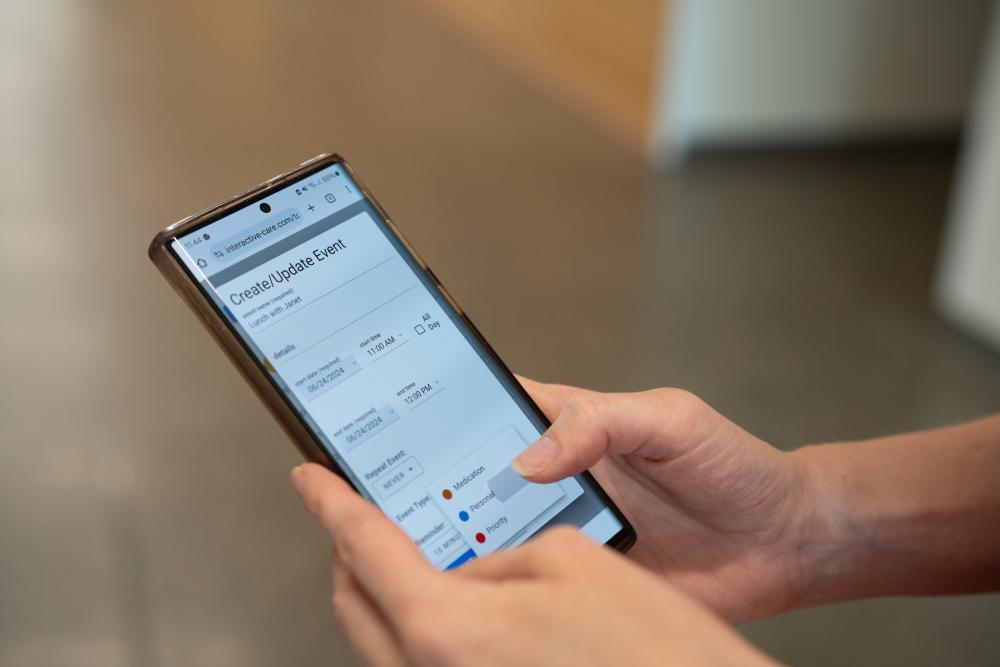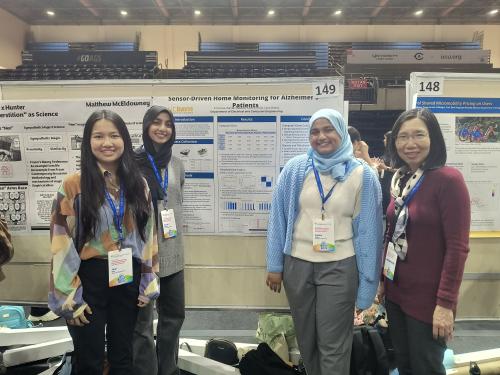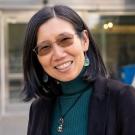
Undergraduate Course Bridges Gap Between AI and Health Care
Projects highlight importance of working across disciplines to engineer next-level solutions

A partnership between Professor of Electrical and Computer Engineering Chen-Nee Chuah and UC Davis Health is turning the Yolo Causeway into an arterial thoroughfare for student learning and innovation in engineering and artificial intelligence at the University of California, Davis.
EEC 174 — "Senior Design Projects in Applied Machine Learning" is an annual, two-part course taught by Chuah that introduces teams of students to the fundamentals and challenges of applied machine learning systems through a senior design project. Students in the past have designed autonomous driving systems and solutions to health-related problems.
This year, thanks to a collaboration with UC Davis Health and financial support from the Healthy Aging in a Digital World Initiative, or HADW, Chuah has made the EEC 174 series a space for students to work across the causeway on cutting-edge AI technologies that ensure adults age with grace.
Shifting Up a Gear
EEC 174 began in 2017 as an independent senior design series focusing on autonomous driving. It expanded to include smart sensing projects for health applications in the 2019-2020 academic year.
Chuah, who was recently named co-director of the UC Davis AI Center in Engineering to lead the center's efforts to advance human health, wanted to open the course up for her students to work on even bigger health challenges and further the course's emphasis on exchanging ideas and working across gaps as an engineer. In other words, in a world where AI is developing into a preeminent tool, she wants to put her students on the road to long-term success. She started soliciting capstone project proposals from her collaborators at UC Davis Health that address real, translational research and clinical needs to achieve this goal.
“I think it’s very important now for our engineering students to work out of their comfort zone,” Chuah said, “and know how to collaborate with other domain experts to pursue interdisciplinary engineering design projects.”
Since the early 2020s, Chuah has participated in a joint research forum with HADW to brainstorm how to facilitate interdisciplinary and cross-causeway collaborations.
In July 2024, she worked with Tod Stoltz, director of business development for the UC Davis Health system, to coordinate a mini workshop as a conversation starter between engineering faculty members and clinicians from the UC Davis School of Medicine and the UC Davis School of Nursing. The workshop discussed how ECE senior design capstone teams can be steered towards creating technology solutions for healthy aging in a digital world.
"Science on that end of the causeway," said Stoltz, referencing the medical campus in Sacramento, "it takes some time to see where the opportunities are, especially with emerging tools like AI. Chuah is great at bridging that chasm between technology and care, plus thinking through the ways AI can have an impact in new environments."
Following the mini workshop, Chuah reached out to Alyssa Weakley, a professor of neurology, and Shelly Fritz, a professor of nursing known for her research on smart homes, about working together on project proposals for EEC 174 related to elderly care.
They collaborated on proposals ranging from a smart home sensing device for detecting infection to home sensors capable of identifying anomalies in a patient's daily activities.
"These are projects with real problems, real needs and real societal impact," Chuah said.
Bidirectional Growth
Chuah provided the students from EEC 174 a list of these projects that they could work on, with three teams of four forming to tackle different HADW problems.
One team worked closely with Chuah and Fritz on an ML-driven platform for detecting urinary tract infections by leveraging smart home sensors (think: sensors for light, motion and temperature changes). The other two worked with Chuah and Weakley on projects using video data and vibrational signals to provide warning signs of mild cognitive impairment, or MCI, a condition that is often a precursor to Alzheimer disease.

As these were all much more complicated ideas than students had taken on in previous iterations of the course, this meant that they were also much more research-focused, Chuah explained. This posed a serious challenge.
Thankfully, the funding from HADW allowed Chuah to hire Yui Ishihara, a first-year Ph.D. student in her lab, to get a head start on the research and serve as a teaching assistant and graduate student mentor for the course. Ishihara was already familiar with EEC 174, as she had taken it during her senior year, graduating with a Bachelor of Science in electrical and computer engineering from UC Davis in 2024.
Ishihara worked through several benchmark experiments in computer vision models before students selected their projects. Her work showed that the technology was feasible for machine-learning-enabled home sensors and laid the groundwork for each of the three senior design projects.
“The biggest problem in machine learning is the lack of accessible data for training robust models,” Ishihara said. “Especially in healthcare applications, machine learning is particularly tricky as safely collecting data in a privacy-preserving way is very difficult.”
As a workaround, Ishihara researched and identified publicly available datasets relevant to the students' projects. She also designed lab assignments around these datasets to allow students to focus on exploring core ideas of AI for their projects and the hardware/software integration of edge devices and sensors without becoming overwhelmed by writing code from scratch.
"The most rewarding part of this approach was seeing students ask thoughtful questions and express genuine interest in applying what they were learning," she said. "I think in creating these labs, I learned just as much as the students!"
Lasting Impact and Enduring Partnership
Through their work with Ishihara and Chuah, as well as their collaboration with Fritz and Weakley, the three teams of students working on HADW-related problems completed their senior design projects.

Jinsi Guo, Lana Wong, Zainah Masood and Fatima Shaik, the team's leader, developed Signal Squad. The system uses camera data to add context to vibrations associated with home activities. The data from their sensor can train a machine-learning system to detect an individual's day-to-day activities.
Healthcare practitioners could use Signal Squad's technology to monitor and track the health and habits of adults with dementia who do not have 24/7 care. The team presented their senior design project in the poster session at the 2025 Undergraduate Research Conference at UC Davis on April 25.
The team of George Jenov, Amir Iravani, Yanning Xu and Emmanuel Agubata created NO-HARMS, a computer-vision-based system that uses visual data collected from Weakley's I-Care platform. I-Care is a web platform enabling adults to connect remotely with caregivers who may be miles away. NO-HARMS adds to the platform by allowing caregivers to gain ML-enabled insights into sleep patterns, medication usage, hygiene routines and more.
The team working with Fritz developed the Home Activity Recognition System, or HAR Sys. The system uses an ML-enabled sensor to detect signs of urinary tract infections at a patient's home. The team outfitted the sensors with a Raspberry Pi to ensure predictions could be made on-site. When an infection is detected, the system uses Bluetooth to alert the patient's health practitioner on their mobile phone.
The HAR Sys project is already making noise. Team members Peggy Zhu, Luuanne Chau, Sarbani Kumar and Jieying Li presented their work at the 2025 ECExpo — a yearly industry affiliate event hosted by the Department of Electrical and Computer Engineering — and won the Best Poster Award. In addition, Sandia National Laboratories selected HAR Sys as one of the finalists for the 2025 Sandia Engineering Senior Design Award during the UC Davis Engineering Design Showcase.

"The HAR Sys project strengthened our engineering problem-solving skills, sharpened our ability to communicate effectively with researchers and inspired many creative solutions to tackle real-world deployment challenges," said Zhu, who was the project's leader. "We plan to continue developing this project in collaboration with the [UC Davis Health] research team to further refine the solution for practical, real-world implementation."
For Chuah and Stoltz, this is just the beginning of a two-way street that reaches across the causeway and reveals the rewarding partnerships between engineering education, AI research and medicine.
"There are so many cool projects that we could do in collaboration with the School of Nursing and School of Medicine," Chuah said. "These are just a few examples. From my perspective, every year I'm going to go and solicit interesting projects for our [EEC 174] students, and it may or may not be from Healthy Aging in a Digital World, but I could see enough synergy between it and innovations in AI that I suspect the partnership will be long-lasting."

